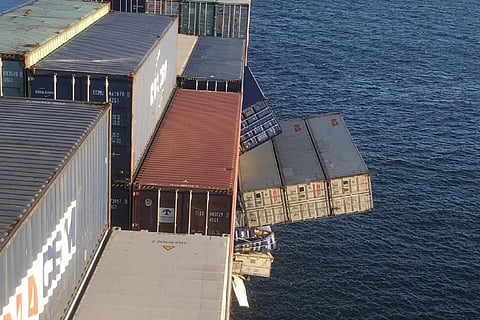

What is going on in the North Pacific, as scarcely a week goes by without stacks of containers hurling themselves into the sea as ships roll extravagantly in the heavy weather they seem to be encountering? Is the weather any worse than might be expected during the winter season in this notoriously fickle route between Asia and North America?
It doesn't take much for those who incline to climate activism to attribute the current spate of accidents to what they believe is increasingly violent weather, but it might be that there are more prosaic causes. Could there be something of an "operational" reason, in that there is increased pressure for masters to maintain their schedules, with diversions well clear of threatening weather disapproved of by management?
In such a climate, masters will maintain their course and speed and press on, when prudence might suggest otherwise. It could be that external weather routeing agencies hired to give advice to ships also feel pressure upon them not to be "too cautious" in their recommendations.
We know, for instance, that the general reduction of speed on passage, designed to save fuel (and the environment), has increased the pressure to speed up the processes elsewhere, such as in port waters and at terminals, to make up what has been lost. This, of course has not been helped by the advent of the latest very large ships, with their huge container exchange demands, upon the terminals. Operators and charterers "squeeze where they can," and no master can be unaware of such pressure.
It would be a very bold commentator who would suggest that the pressure to get a ship off the berth and away to sea in the shortest possible time, accommodating late deliveries of urgent boxes, does not contribute to short cuts in the lashing regime. Masters who know what they are talking about have commented on the pressures in final load ports playing fast and loose with cargo plans, with heavier boxes ending up higher than they ought to be.
It also seems obvious that with ships carrying far more on deck than under deck, with stack heights ever higher, the stresses upon the lashing arrangements are going to be far greater. It might be suggested that lashing arrangements have been properly verified by class and the authorities, but do these really take into account the sorts of forces that will arise, should there be an almost instantaneous loss of stability in the event of a parametric rolling event? And has there ever been a proper investigation of the forces acting upon the container stack of such extreme heights in a seaway – in real terms – rather than those estimated in a computer program?
It might be asked that if a certain arrangement is deemed safe and practical when containers are six high on deck, what additional arrangements are put in place when the stack is ten high? Are the lashing rods and turnbuckles suitably strengthened for such increased forces that may act on a stack? The answer, one might suggest, is that the equipment is already as heavy as a well-muscled lashing operative can reasonably lift and cannot, at a reasonable cost, be made any stronger.
It is, fundamentally, the same sort of equipment that was fashioned half a century ago to deal with far smaller deck loads. It is also worth noting that ships' crews, who might have been available to check on the lashing tensions during the passage, have halved in number while the ships have quadrupled and more in capacity.
It is notable that there is something of a dichotomy in the attitudes of different carriers to the use of lashing bridges, which, of course are part of the ship structure. Some carriers now carry lashing bridges on their largest and newest ships, to enable containers six high to be secured in this fashion, leaving only three or four to be fastened on top with twistlocks. Others make do with bridges that are considerably lower, several of the ships that have experienced serious losses being of this type.
It may not be a coincidence that the period in which we have seen the most spectacular stack collapses has been one in which the carriers have been struggling to meet demand for eastbound trans-Pacific slots. Following the onset of the pandemic, trade fell away and sailings were cancelled, but for the last several months, it has sharply rebounded and ladings have been arguably heavier than ever. If a stack is going to collapse for whatever reasons (and there are many of them) it is more likely to happen if the boxes are heavier, than if they are more lightly loaded.
The suggestion that ships ought to be less heavily laden in areas of expected heavy weather on a seasonal basis might seem to be common sense, but is unlikely to commend itself to those who operate these monsters. They will continue to point out the statistical likelihood of such incidents when compared with the numbers of boxes carried. It is an argument that may well resonate rather less if the accidents continue, or, in the worst possible case, a ship is lost.
